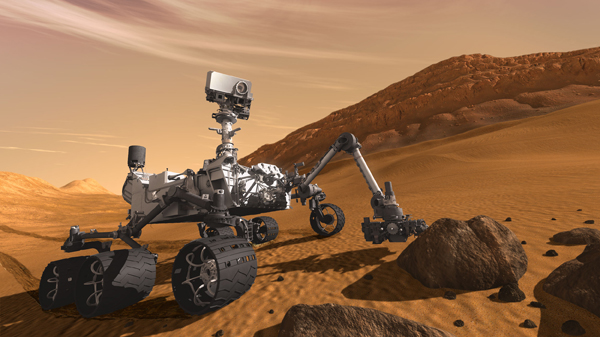FAQ: Mars Science Laboratory and Curiosity Rover

NASA’s Mars Science Laboratory is scheduled to begin its journey towards Mars this Saturday (Nov. 26). Here’s everything you need to know about the $2.5-billion mission and its rover, Curiosity.
What are the mission’s goals?
The Mars Science Laboratory mission’s main goal is to determine whether the Red Planet is, or ever was, capable of supporting microbial life. The mission is not designed to figure out if life has ever actually existed on Mars, nor is the rover capable of making such a determination — the mission’s goal is simply to gauge the planet’s habitability.
The mission has four primary science objectives, which, together, will help scientists assess Mars’ potential for past and present habitability.
- Evaluate the planet’s biological potential by searching for organic carbon compounds and other chemical elements important for life, such as nitrogen, phosphorous, sulfur and oxygen.
- Analyze the geology of the rover’s field site, the Gale Crater, to look for clues of an energy source for life.
- Describe the evolution of Mars’ atmosphere, how it's currently distributed around the planet, and how water and carbon dioxide cycle through it.
- Characterize the planet’s surface radiation, which could pose a hazard to life and break up organic compounds.
What is the timeframe for the mission?
The Atlas V rocket carrying Curiosity is set to launch from Cape Canaveral Air Force Station in Florida Nov. 26, 2011. NASA’s window of opportunity to send the rover to Mars extends until Dec. 18, 2011, after which time the rocket will not likely be able to reach the planet. With its current schedule, Curiosity is expected to land inside of the huge Gale Crater on Mars Aug. 6, 2012. The primary mission will last one Mars year, or 98 Earth weeks.
How does Curiosity stack up to previous rovers?
Get the Space.com Newsletter
Breaking space news, the latest updates on rocket launches, skywatching events and more!
Curiosity is the largest Mars rover to date. Weighing in at nearly 2,000 pounds (900 kilograms), Curiosity is about 10 feet long, 9 feet wide (around the size of a small SUV) and 7 feet tall, counting its camera mast (3 meters, by 2.8 meters, by 2.1 meters).
The rover has a 7-foot-long robotic arm with joints that allow it five degrees freedom of movement, giving it plenty of dexterity to brush rock surfaces clean, collect samples and perform several other experiments.
Curiosity has six 20-inch-wide (0.5 meter) wheels capable of pushing the vehicle along at up to 1.5 inches per second. All the wheels have driver motors, and each front and rear wheel can be independently steered. The rover also has a suspension system that keeps all its wheels in contact with the ground at all times, even when going over uneven terrain.
Unlike its solar-powered predecessors, Curiosity carries a nuclear power source — the system generates electricity from the heat created by the radioactive decay of plutonium. The power source will allow Curiosity to explore Mars for a full Martian year, and possibly longer. [Could NASA Rover Find Signs of Martian Life in Giant Crater?]
The rover has 10 different scientific instruments onboard to help it carry out its mission.
What are the rover’s instruments?
Curiosity’s 10 instruments have a variety of functions.
Several of the instruments will focus on taking photographs and video. MastCam, for example, will take pictures and video of the Martian landscape, while MARDI will record the rover’s descent to the planet’s surface. Another camera, MAHLI, will take color images of Martian features smaller than the width of a human hair.
Other instruments will analyze Martian materials. SAM, the heaviest of all of the instruments, will search for carbon-containing compounds and other life-related elements. Two of the instruments will use X-rays for their experiments: CheMin will emit X-rays on material samples to identify the minerals' crystalline structures, and APXS will use X-rays to measure the quantities of various chemical elements. By firing beams of neutrons into the ground and measuring how they scatter, the DAN instrument will help the rover search for ice and water trapped in subterranean minerals.
Perhaps most interesting of the analysis tools is ChemCam, a rock-zapping laser and telescope. The instrument will vaporize a pinhead-sized portion of Martian rocks by firing a fine laser at them, which it can do from up to 23 feet away (7 meters).ChemCam’s telescope will then analyze the spectrum of light scattered from the object to identify its chemical composition. This will allow Curiosity to study rocks that are beyond reach of its robotic arm.
Curiosity’s final two instruments, RAD and REMS, will measure ambient radiation and analyze Mars’ weather, respectively.
How does the landing scenario work?
When the previous Mars explorers Spirit and Opportunity arrived at the Red Planet, they took a ballistic approach to reach the planet’s surface — airbags inflated around the rovers, allowing them to smack into the ground unharmed. This technique won’t work with Curiosity because of its greater size and weight, so NASA has designed an innovative process to guide the rover safely to the surface.
When the spacecraft carrying Curiosity breaches the Martian atmosphere, air friction will cause it to steadily slow down. During this time, the spacecraft will fire thrusters to help guide it towards the landing target. It will then deploy its parachute to slow down further. The spacecraft will use a landing radar to identify a good spot to land.
As it gets nearer to the surface, the spacecraft will detach from its back shell and parachute and use retro rockets to decelerate. In its final seconds before touchdown, the spacecraft will use a special crane to lower the rover away from the craft, and Curiosity’s wheels will deploy. Once the rover settles on the ground, the spacecraft will crash safely away from Curiosity.
What is the landing site like?
The Gale Crater, Curiosity’s landing site, is 96 miles (154 kilometers) across, or about the size of Connecticut and Rhode Island combined. The crater contains a mountain three miles high, with slopes that are climbable by Curiosity.
The crater site was chosen because it may have been wet at some time in Mars’ past. Gale is at a lower elevation than most of the surface of the planet, so flowing water could likely have pooled inside Gale. Previous observations from orbit have found water-related clay and sulfate minerals in the crater, which support a wet history for the area.
The mound also has other geologic features that make it an interesting region to study, such as stacks of geologic layers that will allow NASA to tease out Mars’ environmental history.
This story was provided by Life's Little Mysteries, a sister site to LiveScience.
Join our Space Forums to keep talking space on the latest missions, night sky and more! And if you have a news tip, correction or comment, let us know at: community@space.com.











